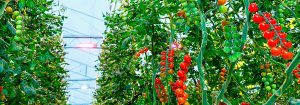Be the first! Get the latest news and updates - Subscribe to our newsletter!
Research by Signify, WUR, and Nunhems shows that long-term exposure of far-red light in tomatoes can produce additional yields
- Adding far-red light during the entire photoperiod alongside the standard PAR light resulted in additional yield
- One of the tomato varieties increased the yield to 16%
Eindhoven, the Netherlands – Signify (Euronext: LIGHT), the world leader in lighting, together with Wageningen University & Research and Nunhems conducted research that shows that the use of far-red light can produce an additional yield of almost one fifth in tomatoes, depending on the variety. The far-red light needs to be added during the entire photoperiod alongside the standard PAR light.
Growers want to get as much as possible out of their LED lights. That’s why Signify, in close collaboration with its partners, is conducting ongoing research into the optimal light recipes and photoperiod (lighting duration) for different crops. This has recently resulted in new insights for tomato cultivation.
It is well-known that the different colors within a light spectrum can have an effect on the development of plants. In fact, crops may react differently to the various colors of light at different times of day. Therefore, this study sought to find the most appropriate time for the application of far-red light. They found that far-red was by far most effective when added throughout the entire photoperiod.
While the outcome confirms the oportunities that far-red light presents , it is not a clear and straightforward equation. “We now have more insight into the impact of far-red light during different periods of the day. The next step is to focus on the ratio between far-red and PAR light to find the ideal balance between growing optimization and energy efficiency.” says Plant Specialist Erik Stappers of Philips Horticulture LED Solutions.

16 percent additional yield
The best result was a 16% increase in yield, however, major differences between varieties make the outcome uncertain for growers. . The 20-week study shows that all far-red treatments give more sink strength, which means that more sugars flow to the fruits. However, this only led to a significant increase in harvest if the far-red was dosed during the entire photoperiod -- in this case 16 hours a day.
The research partners, Signify, Wageningen University & Research and Nunhems, conclude from this that the plant is not more sensitive to this light in the morning or in the afternoon. Far-red light requires more energy than PAR light, which means that the long duration that far-red has to be added leads to higherer energy consumption.
Ratio between PAR and far-red
The question now is the level at which the use of far-red becomes advantageous in relation to the extra energy consumption. If a relatively low percentage of far-red light produces additional yield, then the researchers expect it may become appealing. “We continue to tweak it to find the ideal light recipe for tomatoes. Besides additional yield in kilos, higher quality and better taste may also come into play in the future,” says Elena Jiménez, Plant Pathology researcher at Wageningen University.

Signify, Nunhems and Wageningen University & Research have been working together for about seven years to research the ideal light recipe for tomatoes. Various light recipes are being tested in relation to energy consumption, light spectrum, additional yield and uniformity.
For further information, please contact:
Philips Horticulture LED Solutions by Signify
Daniela Damoiseaux – Global Marcom Manager
Tel: +316 40578311
E-mail: daniela.damoiseaux@signify.com
About Signify
Signify (Euronext: LIGHT) is the world leader in lighting for professionals, consumers and the Internet of Things. Our Philips products, Interact systems and data-enabled services, deliver business value and transform life in homes, buildings and public spaces. In 2023, we had sales of EUR 6.7 billion, approximately 32,000 employees and a presence in over 70 countries. We unlock the extraordinary potential of light for brighter lives and a better world. We have been in the Dow Jones Sustainability World Index since our IPO for seven consecutive years and have achieved the EcoVadis Platinum rating for four consecutive years, placing Signify in the top one percent of companies assessed. News from Signify can be found in the Newsroom, on X, LinkedIn and Instagram. Information for investors is located on the Investor Relations page.
Contact us
Contact certified partners
Philips products are sold through a global network of certified partners. Find partners in your region for more information about Philips LED grow lights.
Contact Philips
What are the best LED grow lights for your situation? We are here to help. Please use our form to submit your request.
Interested?
Learn more about LED lighting in horticulture by reading our latest articles and case studies.

